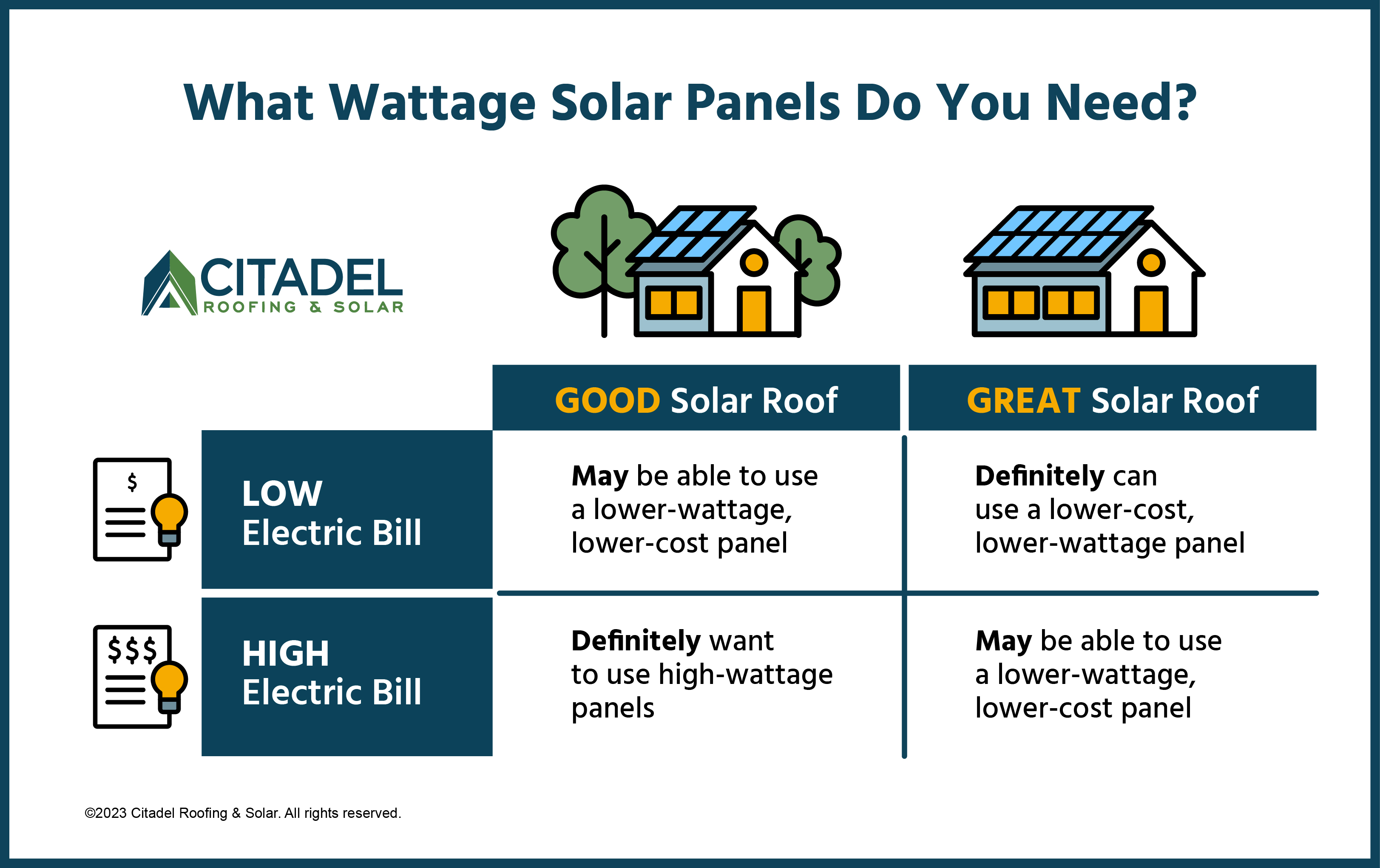Residential solar system size is typically given as the number of panels or, more often, the total wattage of all the panels in the system.
If you monitor your system’s performance online, you may have noticed that the system size doesn’t match the output of your solar at any given point in time. For example, your 9-kilowatt (kW) system may be operating at 8.7 KW, 8.2 KW, or less. This may leave you wondering, why doesn’t it ever produce at its full capacity?.
We explain in this article. Specifically, we’ll cover:

- What panel wattage even means
- How wattage is determined, using the STC and PTC methods
- Differences between STC and PTC ratings
- How these ratings impact which panels you might consider for your home
- Tips for maximizing system performance regardless of panel wattage.
What is solar panel wattage?
The wattage of a solar panel is a number that describes the panel’s maximum capacity to produce solar energy, or its potential power output. Different residential solar panels have different strengths, which range from 350 to 430 watts per panel these days.
A home solar energy system with 25, 400-watt panels has 10,000 watts, or 10 KW, of potential capacity.
One 400-watt panel has 400 watts of potential capacity. Theoretically, it can produce 0.4 kilowatt-hours of electricity in, you guessed it, one hour. But that’s under ideal conditions. Below we explain the two main methods used to rate solar panels and determine their watts.
(Note that both of these methods determine “DC watts” which is a theoretical number. You may also come across AC ratings for panels, which tend to be slightly lower than DC.)
What is a solar panel’s STC rating?
The STC panel output rating is measured in a laboratory under ideal conditions for power production. STC stands for Standard Test Conditions. It is a theoretical number, representing the peak production capacity of the panel. It is also the “nameplate” rating assigned to panels, so something homeowners may come across in their solar research.
Thankfully for consumers, the entire solar industry applies this universal standard for rating panel wattage. This means you can rest assured you are comparing apples to apples when you look at panels from different manufacturers when it comes to their capacity. One company’s 350-watt panel should produce roughly as much solar electricity as another company’s 350-watt panel.
(Having said that, one of the apples may be extra-large while the other on the small side: The exact wattage of a 350-watt panel falls within a range because few if any panels have exactly 350 watts of capacity. Some degree of variation is expected and allowed when ratings are determined.)
When panels come off the manufacturing line, the company tests them using these Standard Test Conditions. These conditions prescribe the temperature of the panels and solar cells (77 degrees F) and the amount of artificial “sunlight” hitting the panels. In addition to ensuring consistent rating of panels across the industry, the measurement and rating process ensures that the product meets certain standards for quality, performance and safety.
However, the ideal conditions used in STC are not the same as the real-life conditions you would find on your California rooftop. That’s where PTC comes in.
What is a solar panel’s PTC rating?
PTC is a method of testing panel power output under more realistic conditions than STC, because panels never operate in a perfect situation. Actual solar panel production is affected by weather variables including air temperature, hours of sunlight, wind, and how clear or cloudy the day is. (It also varies based on the pitch and direction of the roof upon which it sits.)
So while PTC is also standardized across the industry like STC, the conditions it replicates are different. To more accurately resemble real life, the ambient temperature used under PTC is 68 degrees F but the solar cells in the panel are at 113 degrees F, which is considered normal operating cell temperature. This matters because as panels get hotter, their voltage goes down, meaning they produce less energy. PTC also creates a slight breeze flowing across the panels.
The PTC rating program was developed by the U.S. Dept. of Energy’s National Renewable Energy Laboratory (NREL). PTC stands for PVUSA Test Conditions, which is the short version of the full name—Photovoltaics for Utility Scale Applications Test Conditions.
The California Energy Commission requires panels installed in our state to have a PTC rating as part of their certification process.
How do STC and PTC rating results differ?
In short, STC is a theoretical measurement of panel power output, while PTC is more realistic, as we’ve explained.
But what’s the difference, and how do you use this information?
As a general rule, the PTC rating might be 10-15% lower than the STC rating. This range varies greatly by panel, however, and may be less than that for some brands and models. And even the PTC rating may be lower than what your system can produce, if you live in a particularly cloudy region, for example. Your solar installer can provide you with the ratings for your panels when the system is being designed and they analyze your potential solar production. That proposal, which is based on data for your actual home, is more relevant to what you can expect from your solar than the STC or PTC rating.
The California Energy Commission’s Solar Equipment Lists provides the STC (which they call Nameplate) rating and the PTC rating for every panel installed in the state. Here are a few examples taken from their website:
| Solar Panel Model | STC Rating (Nameplate) | PTC Rating |
| REC 400NP3 Black | 400 | 373.5 |
| REC 420AA Pure R | 420 | 402.5 |
Check out their huge database if you’re interested in more examples.
Do I need the solar panels with the highest PTC rating?
Not necessarily.
In California, roof surfaces are often interrupted by hips, valleys, and dormers, and are often shaded by trees or neighboring homes. This limits the square footage available for solar panels. So Citadel’s goal when designing a residential solar energy system is often to get as many panels on the roof as possible, in order to offset the electric bill to the maximum extent possible.
But when a home has a large, wide open roof, the highest-wattage panels may not be necessary.
The best-designed systems produce the amount of electricity your home needs at the most cost effective price (with panels laid out to be as aesthetically pleasing as possible on your roof’s configuration). Since higher-wattage panels with higher PTC ratings cost more, you’ll pay less if you use the lowest-wattage panel needed to achieve your energy goals.
As this chart shows, the two main factors affecting what wattage panels you need are electricity use and the “solar friendliness” of the roof. By solar friendliness, we mean unshaded, open and ample space with the best “azimuth” or orientation. Because Citadel never installs solar on roofs that just don’t make sense for solar, we can break the roofs we do install on into two categories: those good for solar, and those great for solar.

If roof size is not an issue but you want the smallest system footprint possible, that’s another reason to go with higher-wattage panels.

Should I upgrade my older solar system’s panels?
It depends on whether or not your system is producing enough electricity for your needs.
If it is, and you don’t expect your electricity usage to increase, there’s no need to replace your lower-wattage panels, even though higher wattage panels are now available. As long as your system is still performing and producing electricity, it is still creating value for you. (Solar panel production capacity does decrease over time, but the degradation rate is incredibly small.)
However, if your system is not meeting your needs, then removing the system and installing more efficient panels may make economic sense for you.
How do I maximize my system’s performance?
If you’re concerned about getting maximum solar performance from your rooftop, don’t stress over panel wattage or PTC rating. Think of it like a car. Once you settle on which particular vehicle to buy, you’re not going to lose sleep over the engine’s power. You’re more likely concerned with its performance measured in fuel efficiency or simply its ability to get you from Point A to Point B.
The best ways to get the most from your solar system are:
- Work with an experienced installer that will design the system for maximum production.
- Have microinverters or optimizers installed under each panel, which is standard practice today with the solar systems Citadel designs and installs.
To learn more about solar, see our blog articles on:



